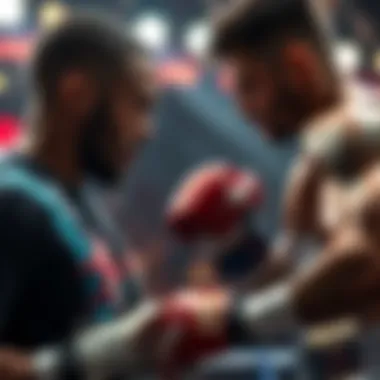Understanding PFL Fight Odds: A Comprehensive Guide


Intro
Navigating the world of betting, particularly in the realm of Professional Fighters League (PFL), can be both exciting and overwhelming. The odds displayed for PFL fights serve not just as numbers; they represent a complex interplay of statistics, fighter performance, public sentiment, and market dynamics. Understanding these odds is essential for anyone looking to place educated bets. It’s more than a game of chance. It’s about making informed decisions based on empirical data and keen analysis.
In this guide, we will delve into the numerous factors that shape these odds. We'll explain the various betting strategies that can enhance your chances of success, while also taking a closer look at the psychological aspects that influence both bettors and bookmakers. Whether you are a novice venturing into the betting arena or a seasoned pro refining your strategy, this guide is designed to arm you with the knowledge to navigate the PFL betting landscape confidently.
Betting Strategies
Basics of Betting: Understanding Odds and Payouts
Before diving deep into strategies, it's crucial to grasp the foundational elements of betting odds. In essence, odds reflect the likelihood of a particular outcome occurring during a PFL event. They can be presented in various formats: decimal, fractional, or moneyline, each with its nuances.
- Decimal Odds: These indicate the total payout rather than just profit. For example, odds of 3.00 suggest that for every dollar you bet, you'll receive three dollars back if successful.
- Fractional Odds: Common in the UK, these show profit relative to your stake. Odds of 5/1 mean you get five dollars profit for every one dollar bet.
- Moneyline Odds: Most popular in the U.S., these indicate how much you need to bet to win a certain amount. A moneyline of -200 means you need to stake $200 to win $100.
Understanding payouts involves basic calculations where you multiply your stake by the odds. Clarity on these terms paves the way for more intricate betting strategies.
Advanced Betting Techniques: Value Betting and Arbitrage Strategies
Once you’ve grasped the basics, you may want to explore more nuanced strategies that can give you a leg up.
Value Betting entails identifying discrepancies between the perceived probability of an outcome and the actual odds offered by bookmakers. To profit from this technique, you need to research fighter performances, injuries, and any relevant stats that might not be fully accounted for in the current odds. Simply put, you’re betting on what you believe is a 'mispriced' outcome, akin to finding a well-hidden gem in a crowded street market.
Arbitrage betting is another method that savvy gamblers utilize to guarantee a profit regardless of the fight outcome. This technique involves taking advantage of differing odds across multiple bookmakers. By betting on all possible outcomes with calculated stakes, you ensure a profit margin. Imagine finding two shops selling the same item at different prices, allowing you to buy low in one and sell high in another – that’s arbitrage in action.
Both these strategies require diligence and constant market monitoring, but they can be a potent tool for reducing the house edge.
"Understanding odds is not just about numbers; it's about context and calculations, blending knowledge and intuition to bet wisely."
Psychological Elements in Betting
Beyond numbers and strategies, understanding the human element is just as vital. Bettors are influenced by a plethora of factors—confidence levels, biases, and even cultural trends. It’s essential to check biases when making a decision; often, our perception alters our judgment of fighters.
By recognizing how psychological factors pressure decisions, you can enhance your betting strategy significantly. It allows bettors to think critically and make choices that might fly under the radar of the more emotional competitors.
In the world of PFL betting, it's not just about fighting skills inside the cage. Understanding the landscape of fight odds positions you to engage thoughtfully and strategically in your betting pursuits.
Prolusion to PFL and Fight Odds
Understanding the concept of Professional Fighters League (PFL) and the associated fight odds is quite vital in the realm of sports betting. With nuances that cater to both tension-filled arenas and analytical minds, PFL isn't just another fighting league on the block. It offers a unique blend of competition and strategy, attracting a diverse audience ranging from seasoned gamblers to casual fans looking for some excitement.
The importance of this section is to lay a solid groundwork that defines what the PFL is and clarifies how fight odds function. For anyone looking to compete with the bookies, grasping these elements can be the difference between a well-informed wager and a blind gamble.
What is the Professional Fighters League?
The Professional Fighters League, often referred to as PFL, stands out from other mixed martial arts organizations because it's structured around a regular season, playoffs, and ultimately a championship. Unlike the traditional fight promotion models where fighters compete based on personal contracts, PFL mimics the frameworks of major American sports leagues. This league has gained traction since its inception in 2018, showcasing a series of events that lead to culminative championship bouts. The PFL not only promotes mainstream fighters but also spotlights rising talents, providing them with a platform for exposure.
With a unique format where fighters collect points based on their performances throughout the season, the PFL's innovative approach not only creates thrilling matchups but also allows for a systematic way to evaluate performance metrics. This systematic evaluation becomes valuable when interpreting the fight odds that emerge ahead of each bout.
The PFL distinguishes itself in a crowded arena by integrating technology such as advanced analytics and real-time data monitoring, allowing fans and bettors alike to make informed decisions based on statistics instead of sheer speculation.
PFL makes waves in the sports betting world, and understanding the intricacies of its odds will enrich one's betting experience immensely.
The Concept of Fight Odds


Fight odds serve as a cornerstone for all betting operations, and understanding them is essential for anyone venturing into wagering on PFL bouts. Simply put, odds reflect the probability of a particular outcome occurring in a fight, whether that be a win, loss, or even the round in which the fight may end.
A more nuanced view reveals that odds are also deeply intertwined with other dynamics such as public sentiment, fighter reputation, and betting trends. Bookmakers carefully analyze fighters' past performances and prevailing conditions before setting the odds, which can sway significantly based on market factors. For bettors, interpreting these odds is analogous to deciphering a code; it requires a blend of intuition, insight, and strategy.
Understanding fight odds is not just about numbers; it’s about picking apart the emotional and performance-based layers that influence them.
Accurate knowledge of how odds are calculated can guide strategic betting decisions. Whether one is a powder-keg risk-taker or prefers a safer, calculated approach, the fluctuating nature of fight odds encapsulates the excitement and unpredictability of the sport, making it crucial for bettors to stay vigilant and informed.
In succeeding sections, we will delve deeper into various aspects that influence PFL odds and how one can gain an edge in betting through informed analyses.
Factors Influencing PFL Odds
Understanding the dynamics behind PFL odds is crucial for anyone looking to place informed bets on fights. Odds are not just random numbers; they are influenced by a multitude of factors that can shape the outcome of a betting strategy. By scrutinizing these elements, bettors can increase their likelihood of making smart decisions, enhancing their potential returns. Knowing what's behind these odds allows individuals to adapt their approaches, whether they are seasoned gamblers or just dipping their toes into the betting waters.
Fighter Performance Metrics
Evaluating fighter performance metrics is a vital piece in the puzzle of fight odds. Statistics such as win-loss records, strike accuracy, takedown success rate, and recent fight performances reveal a great deal about a fighter’s potential in the cage. For example, if one fighter has consistently taken down opponents successfully, while the other shows a weaker defense against such techniques, the odds might reflect this disparity.
Additionally, one might observe metrics across multiple fights rather than just the latest match. Consider a fighter who's lost recently but performed admirably in earlier bouts. This can sometimes lead to skewed odds that don’t accurately represent their skill level, allowing astute bettors to find value in their wagers.
Historical Fighting Styles
Different fighters possess varying styles: some might excel in striking, while others may rely on grappling or submissions. These styles critically influence how fights play out and how odds are determined. For instance, a explosive striker facing a skilled wrestler might see the odds fluctuate based on stylistic matchups. In this scenario, the books may lean towards the wrestler if historical data indicates that they have a strong track record against strikers.
Betters must analyze past fights, paying attention to how a fighter’s style interacts with their opponents. If a fighter historically performs well against particular styles, it can affect perceptions and the associated odds. Knowledge of these nuances can give discerning bettors an edge in understanding how to place their bets.
Injury Reports and Fighter Fitness
Injuries and overall fitness are significant factors in the world of PFL odds. A last-minute injury often swings the odds heavily towards one side or the other. Fighters often walk into the octagon with varying health levels, which can have a domino effect on their performance potential.
As a bettor, it's crucial to keep an ear to the ground for any news regarding injuries. Monitoring fighters’ health can reveal trends that many overlook. If a fighter has recently battled through injuries, their performance could be compromised, despite public perceptions or prior records suggesting otherwise. Subtle changes in a fighter's conditioning or reports from training camps can often influence odds more than people realize.
Fight Location and Conditions
Where the fight occurs can’t be understated when it comes to odds. Factors such as altitude, climate, and home crowd support play a role in how fighters perform. For instance, a fighter accustomed to training at sea level might struggle when forced to compete at a higher altitude, where the air is thinner. This can lead to slower fight paces or easier fatigue.
Moreover, if a fighter is fighting in their home country or city, they may have the advantage of familiar surroundings and overwhelming crowd support, which can bolster their performance. Consequently, bettors should consider the implications of fight location and current conditions, as they could sway the odds in one direction or another.
Gathering such knowledge and correlating it with the aforementioned factors offers a more rounded view of the betting landscape. As with many things in life, making sense of the fine details can lead to greater success.
"In betting, awareness of surrounding factors can be as important as the fighter stats themselves."
Like a leaf in the wind, bettors who understand the currents often find themselves better positioned to ride the waves of PFL odds.
Types of Betting Odds
In the landscape of PFL fight betting, understanding the various types of odds is crucial for anyone looking to dive deep into wagering strategies. Each type of betting odds provides a different angle on how bettors can evaluate and approach their bets. It's vital for both novice and seasoned gamblers to grasp these concepts, as the nuances in each type can impact decision-making and potential payouts. Betting without this knowledge can be likened to entering a boxing ring without a game plan—chances are, you won't fare well.
Moneyline Odds
Moneyline odds are perhaps the simplest form of betting odds. This type sets a straight win/loss scenario, without adding any complications like point spreads. For instance, when you see odds of +200 on a fighter, it means that for every $100 bet, you would win $200 if that fighter emerges victorious. Conversely, odds of -150 indicate that you need to wager $150 to win $100.
Understanding how to interpret these odds is essential, as they reflect not just the likelihood of each fighter winning but also the bookmakers’ perspective on their chances based on various factors. If a fighter is heavily favored, the moneyline will often reflect that, making it potentially less profitable to bet on them. Looking for value bets comes into play here, allowing savvy gamblers to spot underdogs who might be undervalued.
Point Spread Odds


Point spread odds offer a different layer of complexity. In this system, a bookie assigns a point spread or margin that a fighter must win by for your bet to be successful. This is designed to level the playing field between two competitors, especially when one is favored significantly over another. For example, if Fighter A has a -3.5 point spread against Fighter B, Fighter A must win by at least four points for your bet to cash.
The allure of point spread odds lies in their potential for higher engagement and strategic betting aligned with the specific circumstances of the fight. It’s not just about who wins but how they win. Strategic bettors will often analyze fighter styles, historical match-up data, and training changes to seek opportunities to capitalize on perceived miscalculations in the spread.
Over/Under Bets
Over/Under bets, also known as totals, focus on the combined outcome of various fight metrics, primarily the number of rounds a fight will last. Here, the bookmaker sets a total, and bettors wager on whether the actual number of rounds will be over or under that figure. For example, if the over/under is set at 2.5 rounds, bettors can anticipate whether the fight will last beyond the halfway mark of the third round.
This type of betting is particularly popular for fights where one fighter is either significantly stronger or weaker than their opponent, leading to speculation on how the match will unfold. Additionally, analyzing fighters’ endurance, historical performance, and styles becomes key here, as one can draw parallels with past encounters.
Understanding these odds helps demystify the betting process, allowing for informed and strategic decisions.
Choosing which betting type to pursue can be a game-changer. Each type offers unique perspectives and advantages that can lead to shrewd betting strategies. Be it a straightforward moneyline bet or a nuanced over/under wager, comprehending these odds forms the backbone of effective betting in the vibrant world of PFL.
Analyzing PFL Fight Odds
Understanding how to analyze PFL fight odds is an essential skill for anyone serious about betting on mixed martial arts. It provides a roadmap of sorts, guiding bets based on various factors that can lead to informed decisions rather than gut feelings. This segment delves into the tools and techniques necessary for dissecting the odds effectively, ultimately enhancing your betting strategy.
Statistical Analysis Techniques
When it comes to understanding odds, data tells a story. Fighter statistics are not just numbers; they're insights into performance trends and potential outcomes. Here are several key methods for conducting statistical analysis in the realm of PFL:
- Win/Loss Records: A fighter's history can indicate future performance. Analyzing the win-loss ratio of fighters against similar competition can give perspective on how they might fare in an upcoming bout.
- Fight Style Comparisons: Fighters possess distinct styles—strikers, grapplers, or submission specialists. By comparing statistics from past fights, one can determine how different styles fare against each other. For instance, a fighter that historically struggles against grapplers may present a risk when facing a world-class wrestler.
- Fight Metrics: Metrics such as significant strikes landed, takedown accuracy, and defense rates offer well-rounded insights. Leveraging these statistics can help bettors gauge the likelihood of a fighter's success in specific matchups.
- Conditioning and endurance: Performance trends over recent fights can also signify how well a fighter can hold up through multiple rounds. Look for metrics indicating endurance, such as the number of strikes landed in later rounds, which often display a fighter's stamina and adaptability.
Using Odds Comparison Tools
In the vast world of betting, understanding where to place your bet is as crucial as knowing whom to bet on. Odds comparison tools are indispensable resources that allow bettors to find the best value for their wagers. Here’s how you can utilize these tools effectively:
- Find Variance: Different sportsbooks may offer differing odds on the same fight. Using odds comparison websites helps identify where the best returns might lie. For instance, if a fighter is favored on one site but is more generously priced on another, that disparity can mean additional profit.
- Market Movements: Odds comparison tools also reveal how odds change in real time, providing clues into where the money is going. If you notice a significant shift in odds shortly before a fight, it may indicate public or sharp money confidence in a particular fighter.
- Tracking Promotions: Many platforms offer bonuses or enhanced odds. Keeping an eye out for these promotions can offer lucrative opportunities—turning a standard bet into a potential windfall.
Interpreting Odds Movements
Understanding the mechanics behind odds movements is vital for a serious bettor. Odds don't just reflect the likely outcome of a fight; they also signal how bettors are reacting before the fight. Here are several pointers on interpreting these movements:
- Initial Odds vs. Current Odds: Start with the opening odds and track how they change. Huge shifts often come from sharp bettors placing money on one side, signaling insider knowledge or confidence. If a line moves significantly, analyze the factors at play, whether they be injuries or last-minute weigh-in performances.
- Public Sentiment: A fighter who garners a lot of media and public attention might see their odds shorten. This doesn’t always reflect their true fight potential but rather how the betting public perceives them. Be cautious of betting solely based on hype.
- Injury Reports and Withdrawals: Keep a close eye on any late-breaking news. An injured fighter or a last-minute replacement can drastically affect odds, and savvy bettors can capitalize on the information gap when news breaks just before the event.
Psychological Factors in Betting
In the dynamic world of betting, especially in the context of the Professional Fighters League (PFL), psychology plays a crucial role in shaping decisions. Understanding the psychological factors behind why bettors make the choices they do can significantly influence outcomes. Bettors aren't always as logical as one might think; emotions and cognitive biases often take center stage, impacting the decisions made.
By recognizing these psychological elements, bettors can equip themselves with strategies to mitigate risks and enhance their chances of success. A deeper understanding of the mind can lead to more informed decisions, ultimately contributing to a more effective betting strategy.
Cognitive Biases and Betting Decisions
Cognitive biases, those little quirks in human thinking, can have a massive effect on betting decisions. One common bias is the confirmation bias, which refers to the tendency to search for, interpret, and remember information in a way that confirms one’s preconceptions. For instance, a bettor convinced of a fighter's superiority may seek out past victories as proof while downplaying losses or unfavorable odds. This skewed perspective can lead to poor decisions.
Another example is the availability heuristic. This is when people overestimate the importance of information that comes easily to mind. A recent knockout loss or an underdog’s stunning victory might seem to paint a vivid picture, leading bettors to overvalue those outcomes when making their bets. Saying, "Did you see that fight? There's no way I'm betting against that guy!" reflects this very bias.
To navigate these biases, bettors must strive for a more objective analysis—taking time to sift through a fighter’s entire record, evaluating performance without letting recent events cloud judgment.
The Role of Emotions in Betting
Emotions are another factor adding spice—and sometimes trouble—to the betting experience. The thrill of placing a bet, mixed with the anxiety of waiting for a fight to unfold, can lead to impulsive decisions. It's easy for a bettor to get swept up in the excitement of a major PFL event, leading them to place bets that don’t align with their analysis.


Consider the scenario of a passionate fan: they might be tempted to wager their cash on a fighter simply because they admire their fighting style or resonate with their personality. However, this combination of passion and financial risk isn’t always a recipe for success. Frustration, stemming from previous losses, can lead to chasing losses—an emotional response that often escalates bets in attempts to recover lost funds.
"Approaching betting with a level head is often the best strategy. Emotion-driven decisions seldom end well."
To combat these challenges, it's wise to develop a disciplined betting plan. Setting specific limits, remaining aware of emotional triggers, and taking breaks when necessary can help ensure decisions are based on analysis rather than fleeting feelings.
In summary, the interplay of cognitive biases and emotions is a double-edged sword for bettors in the PFL realm. Understanding their effects can pave the way for smarter decisions, ultimately enhancing the betting experience.
Cultural Impact of Betting in PFL
The PFL has grown into a significant force in the world of mixed martial arts, and alongside its rise, the betting culture surrounding it has evolved as well. Recognizing the cultural impact of betting in PFL is essential for grasping how perceptions shape the nature of wagers and, consequently, the sport itself. This section will delve into the gradual shifts in public perception towards betting, as well as the legal frameworks that are adapting to these changes, thereby influencing attitudes and behaviors in the betting realm.
Shifts in Public Perception
Historically, betting on sports, including mixed martial arts, was often viewed with a sense of skepticism or even disdain. Many individuals associate gambling with negative connotations, such as addiction and irresponsibility. However, with the meteoric rise of the PFL, there has been a notable shift in how society perceives sports betting.
In recent years, sports betting has begun to enjoy a more positive light, similar to how it is embraced in European countries. The legalization of betting in several states in the U.S. brought about a wave of new bettors. No longer is it considered merely a vice; instead, it is increasingly seen as a legitimate form of entertainment.
Just consider how social media has been instrumental in changing views. Influencers and professional bettors share insights, strategies, and even successes regarding betting on platforms like Reddit and Twitter. This has helped cultivate a community around PFL betting, fostering a sense of camaraderie that was previously absent.
"Betting on PFL fights is no longer a clandestine activity, but rather a social engagement, filled with strategies and community insights."
Further, the proliferation of smartphone apps and betting platforms means that fans can easily engage with betting from the comfort of their homes, making it an ingrained part of the viewing experience. This accessibility has even led to an increase in fantasy leagues that incorporate betting components, further intertwining culture, community, and competition.
Betting Regulation and Legal Framework
As betting on PFL becomes more mainstream, understanding the regulatory landscape is vital. Each state in the U.S. has differing laws concerning sports betting, and navigating this can feel like walking through a minefield for novice bettors.
Initially, the Supreme Court's repeal of the Professional and Amateur Sports Protection Act in 2018 catalyzed this transformation. This paved the way for individual states to legislate their own sports betting laws. Consequently, states like New Jersey and Pennsylvania rapidly embraced sports betting, drawing in both casual and serious gamblers.
The regulations often include stipulations aimed at protecting consumers while also ensuring fair play. Licensed operators must follow strict guidelines about transparency and responsible gambling practices. These frameworks help in addressing concerns related to gambling addiction and fraud, which can arise in sports betting.
Here are some key factors at play in the regulation of betting in PFL:
- Licensing: Legal betting sites must acquire licenses from their respective state authorities, ensuring they meet specific operational standards.
- Advertising Regulations: States often have rules dictating how betting sites can advertise, aimed at preventing misleading or overly aggressive marketing.
- Consumer Protection Measures: Regulations may impose requirements for self-exclusion programs and provide resources for individuals seeking help for gambling-related issues.
As various states continue to evolve their betting laws, the intertwining relationship between legal frameworks and the cultural acceptance of betting will likely continue to shape how fans engage with the Professional Fighters League. These shifts signify a more integrated approach to sports and betting, marking a positive change in perceptions and practices relating to the sport of mixed martial arts and its bettors.
Epilogue and Future Trends
The landscape of betting within the Professional Fighters League has seen a notable transformation, echoing larger trends within combat sports and the gambling industry at large. Understanding these conclusion and future trends is paramount for both the aspiring bettor and the seasoned gambler. It’s not just about placing a bet anymore; it’s about comprehending the overall shifts in betting practices and the implications they hold for future events.
The Evolution of Betting Odds in Combat Sports
Betting odds have evolved drastically over recent years, influenced by several factors. To start with, the rise of legal sports betting in various jurisdictions has undeniably reshaped the landscape. As states in the U.S. like New Jersey and Pennsylvania have opened doors to regulated sports betting, a new wave of betting operators has flooded the market. This influx has created a more competitive environment, leading to better odds for customers. No longer do gamblers have to settle for stagnant odds; they can compare across multiple platforms.
Additionally, the way odds are calculated has undergone a significant shift. The traditional structures that once governed betting have been augmented by data-driven approaches, utilizing sophisticated algorithms. Trends in fighter performance, injuries, and even the psychological aspects of the fighters are integrated into these odds, leading to a more accurate representation of expected outcomes.
- Historical Data Utilization: Modern sportsbooks now heavily rely on historical data, which allows them to assess previous performances more closely than ever.
- Real-time Adjustments: Odds can shift rapidly in response to new information, whether it's a last-minute injury or an unexpected change in fight strategy. This nimbleness can catch new bettors off-guard but provides an opportunity for those who are vigilant.
Technological Advances in Betting Analysis
As technology continues to advance, so do the platforms and methods used for analysis in fight betting. One of the most prominent trends is the development of apps and websites with live betting features, allowing gamblers to place bets in real-time as the fights progress. This has opened a whole new arena, where strategies can shift mid-fight based on the unfolding action.
Furthermore, advances in data analytics and machine learning are facilitating deeper insights into fight outcomes than ever before. Bettors can now access intricate statistics and tailor their betting strategies accordingly. Here are several crucial advancements:
- Predictive Modeling: Enhanced algorithms predict fighter outcomes based on comprehensive historical data and current form analysis.
- AI Analysis: Artificial intelligence is becoming a game-changer, providing bettors with insights they may not readily see. These systems analyze vast amounts of data instantly, offering suggestions on potential bets and odds movements.
- Blockchain Technology: With increasing interest in cryptocurrency, some betting platforms are exploring blockchain for its transparency and security, further optimizing the betting experience.
“The evolution of technology in betting is akin to the fighters in the cage; it keeps adapting, pushing boundaries, and reshaping the landscape.”
In summary, the conclusion and future trends within PFL fight odds signify not just a change in numbers, but a sign of a shifting paradigm. As the gambling landscape becomes more nuanced and data-driven, the intelligent bettor will keep pace with these evolutions.















